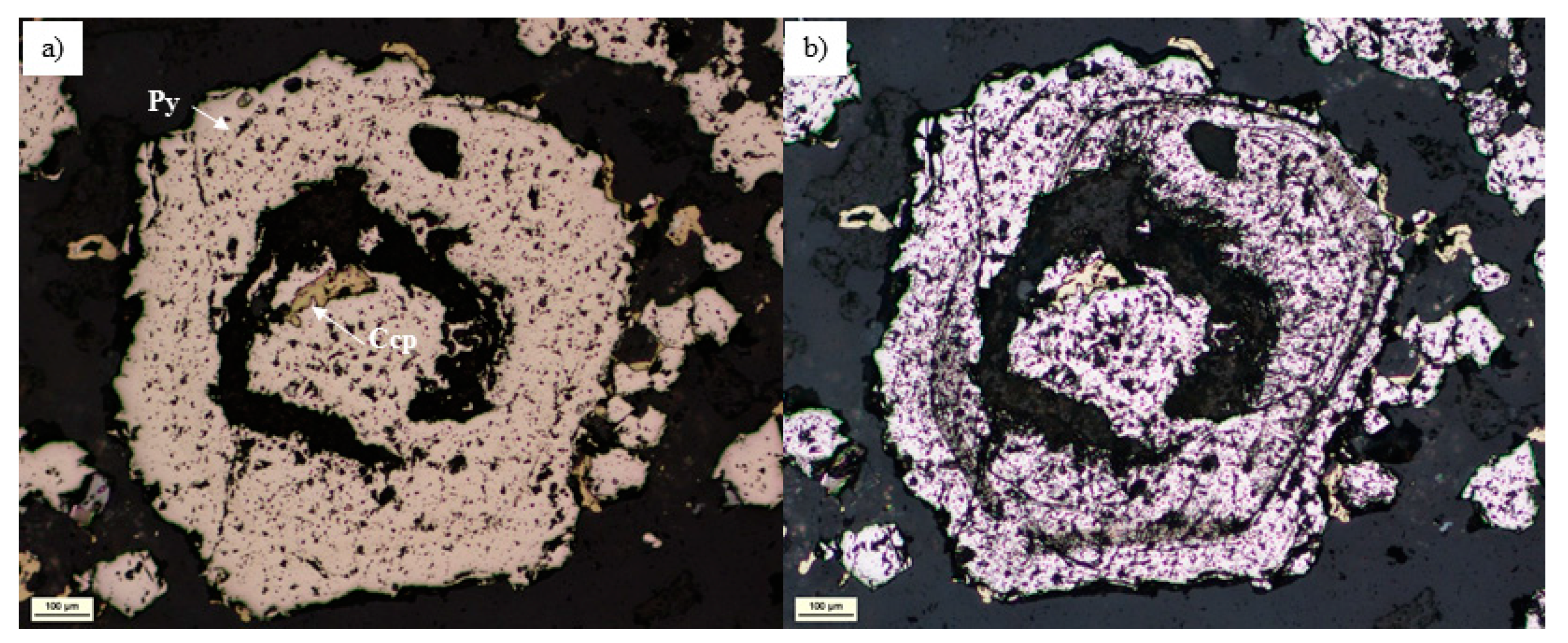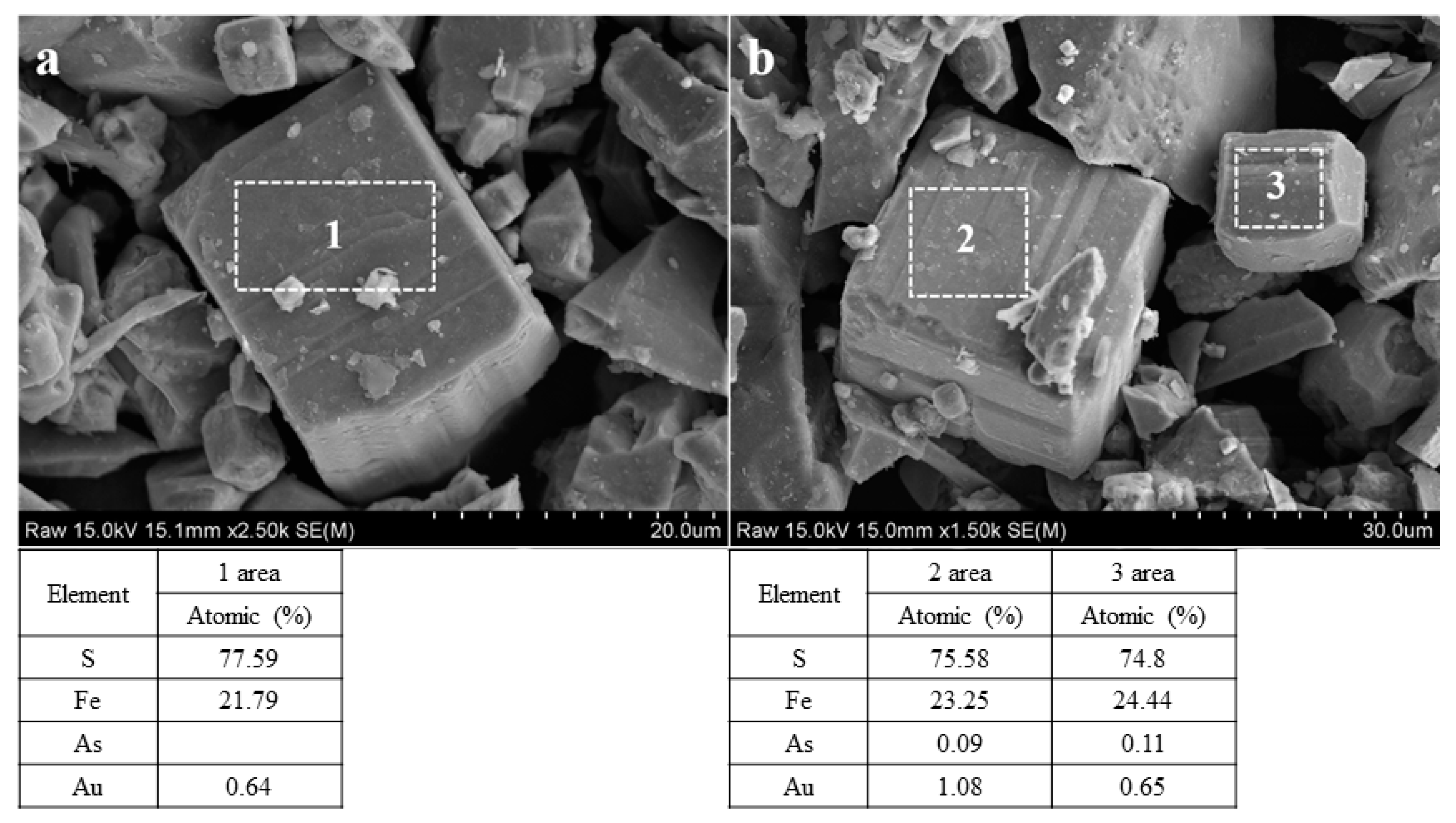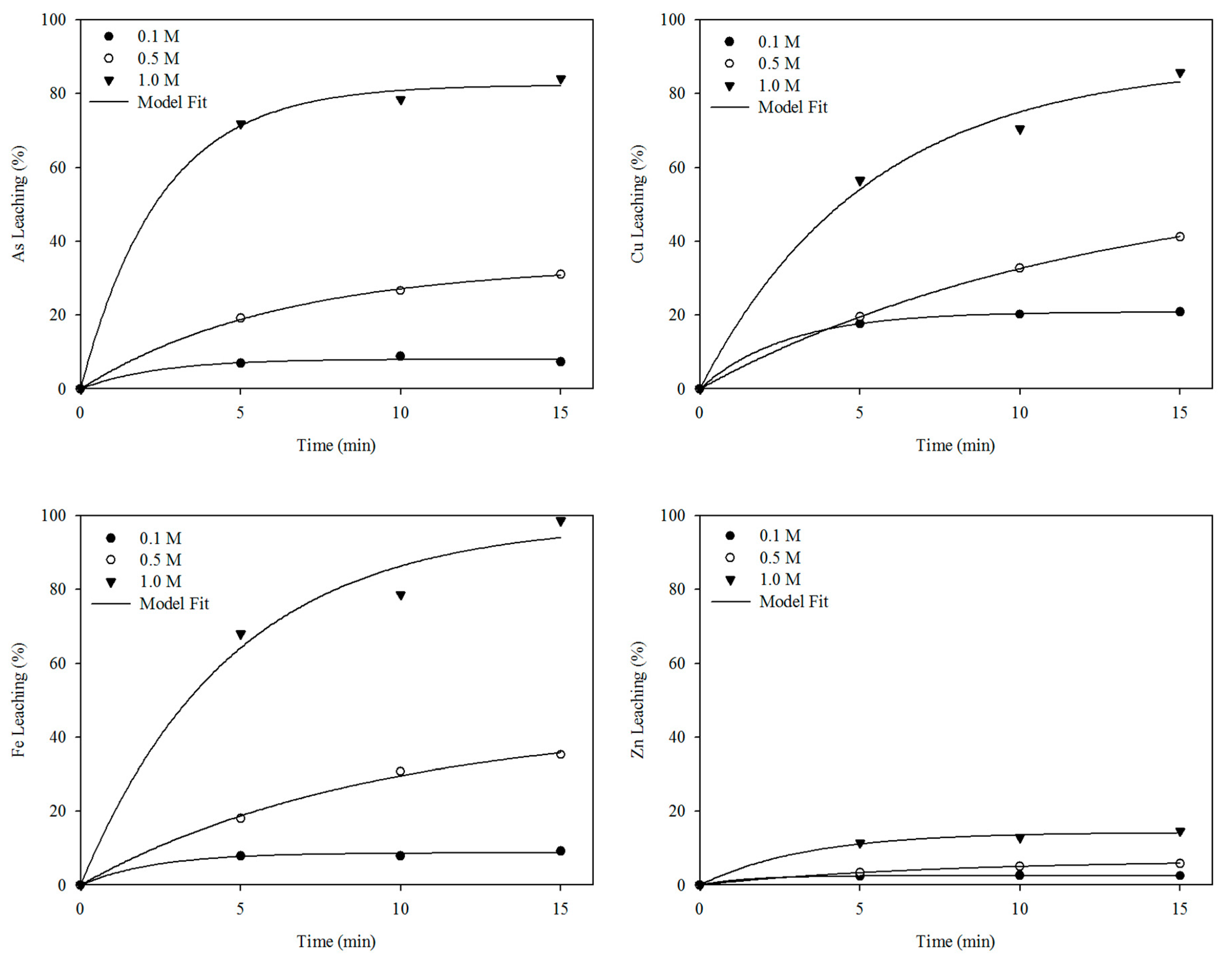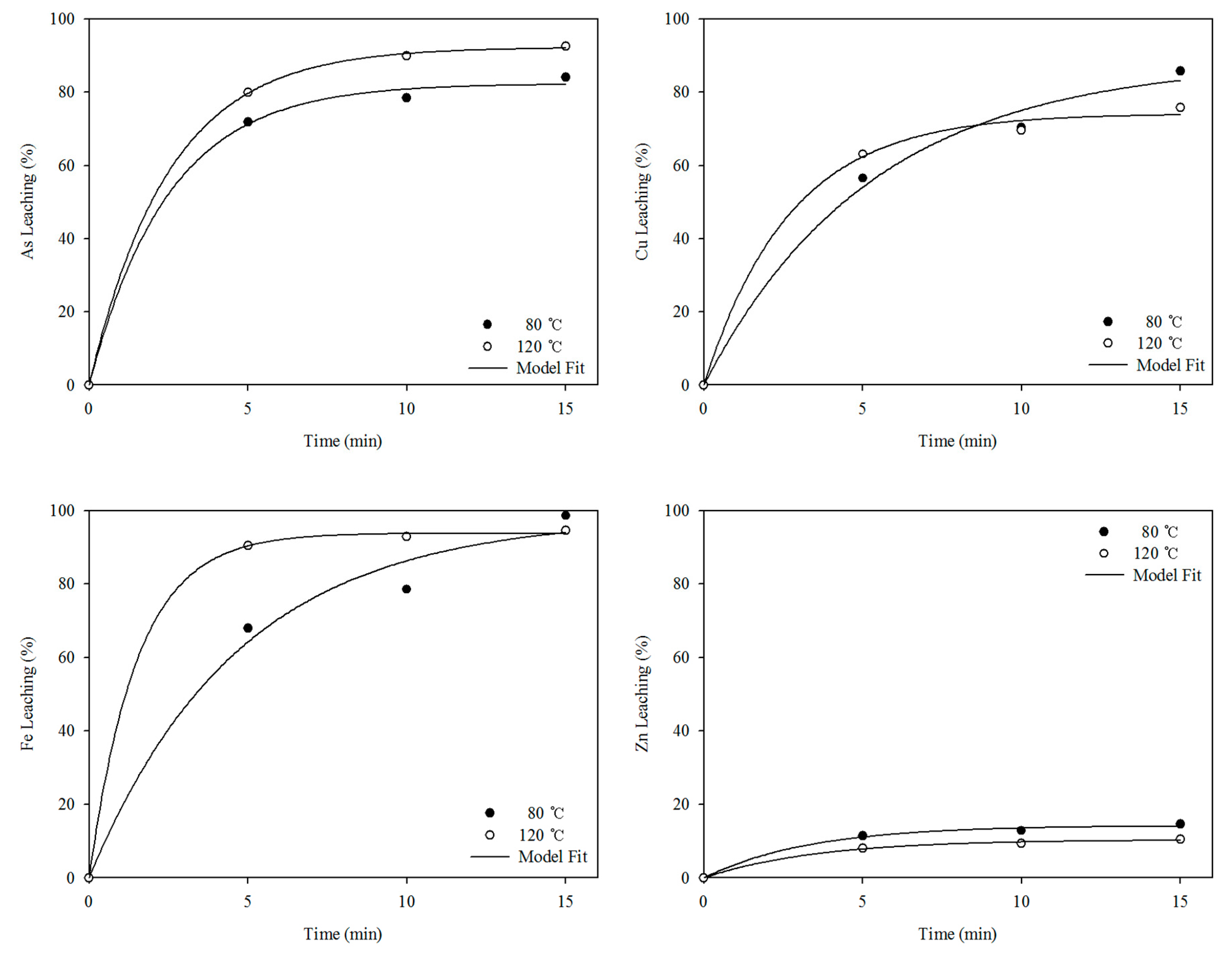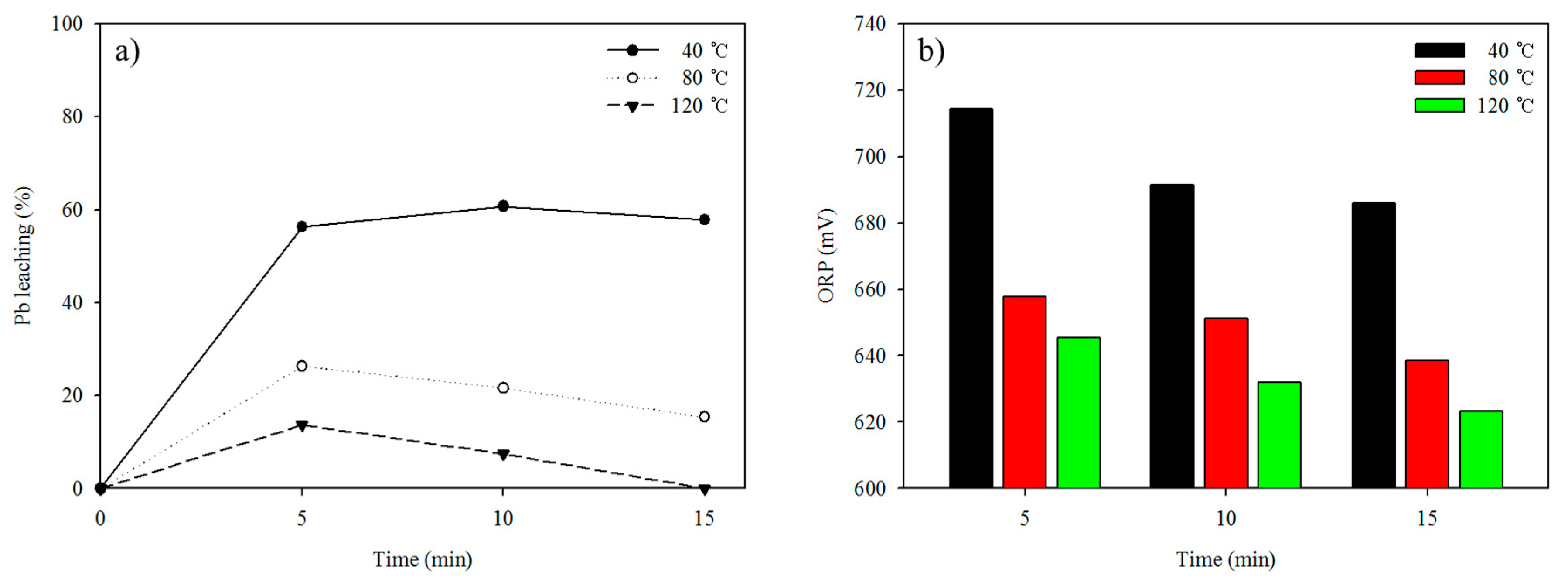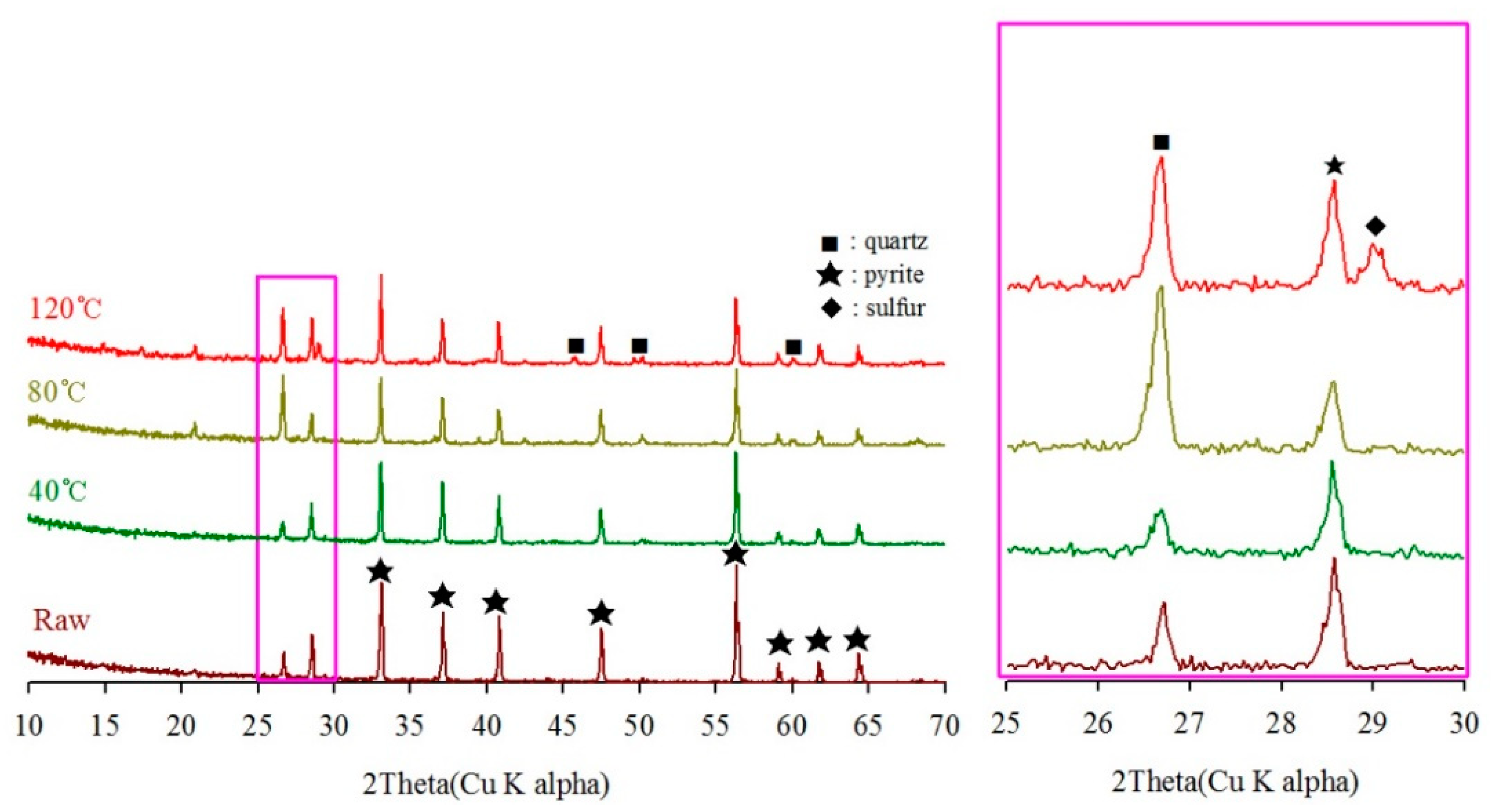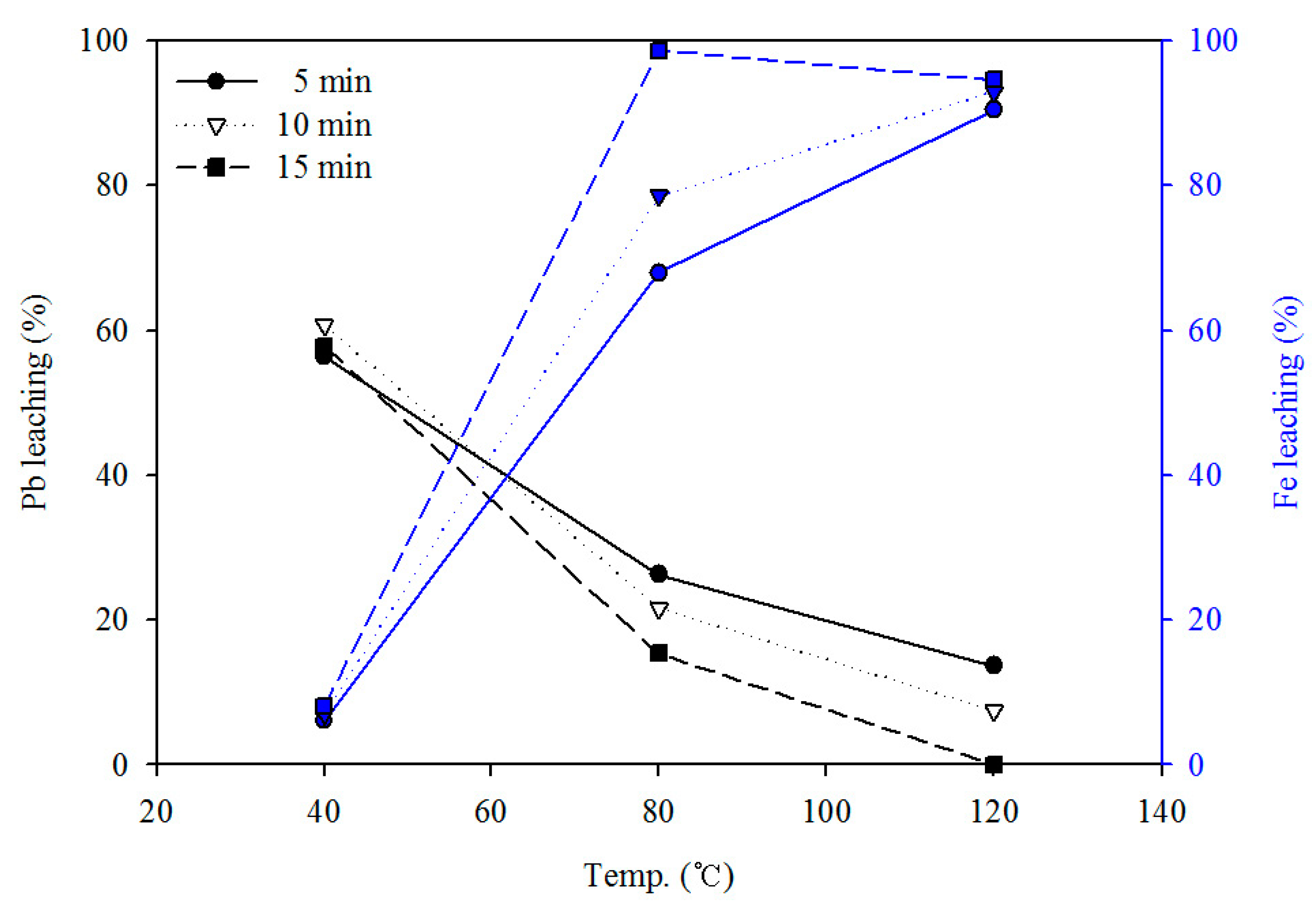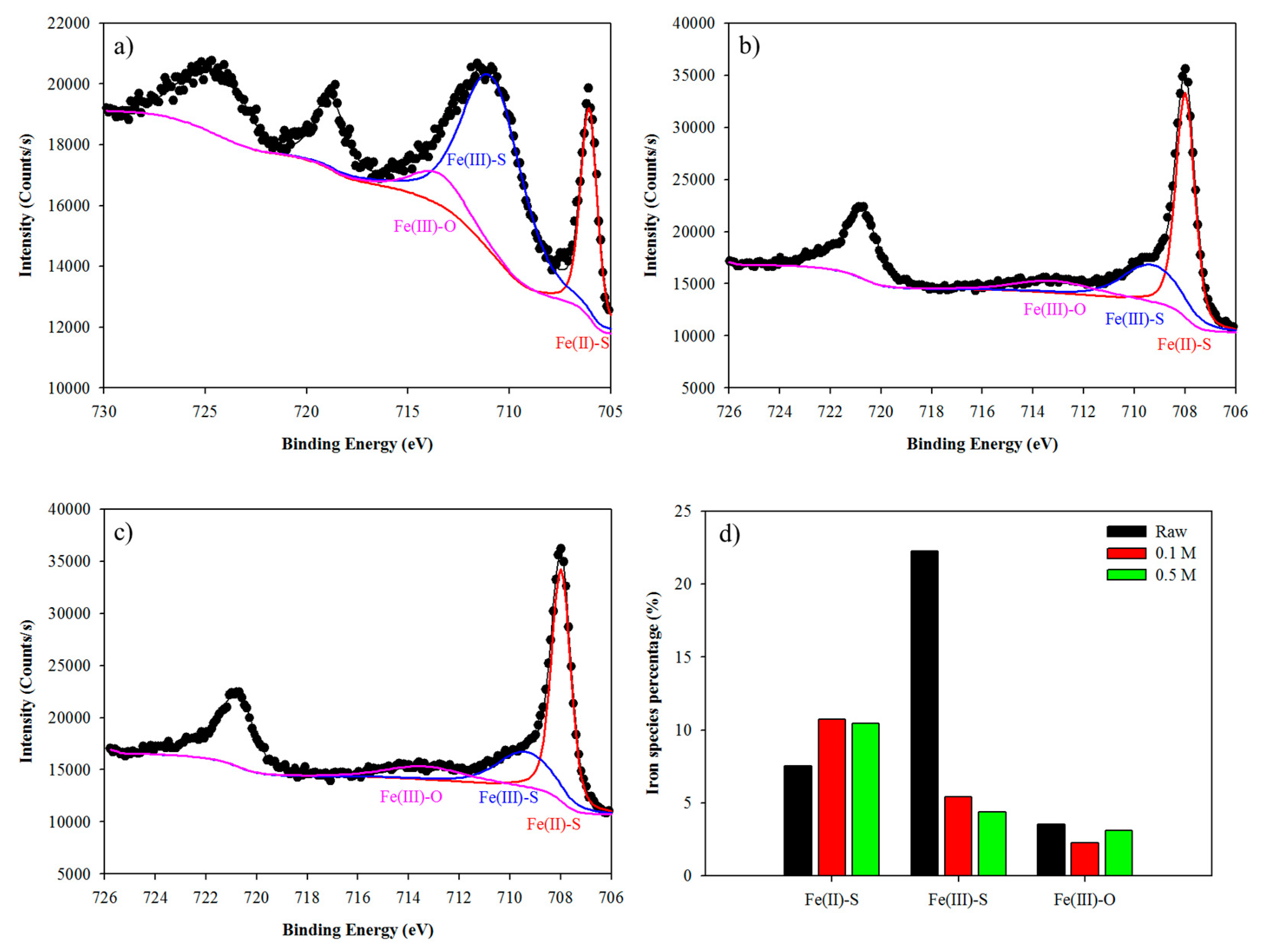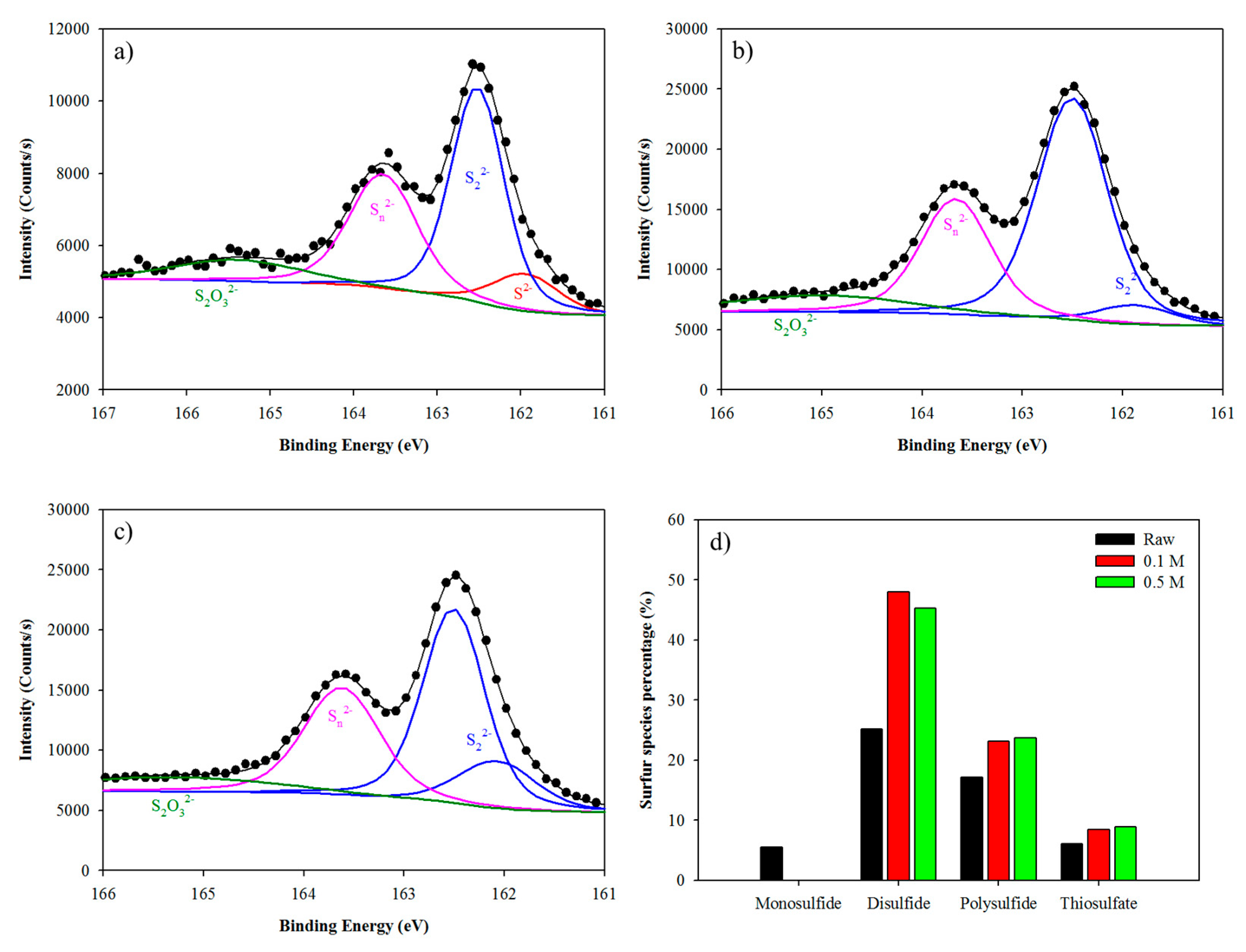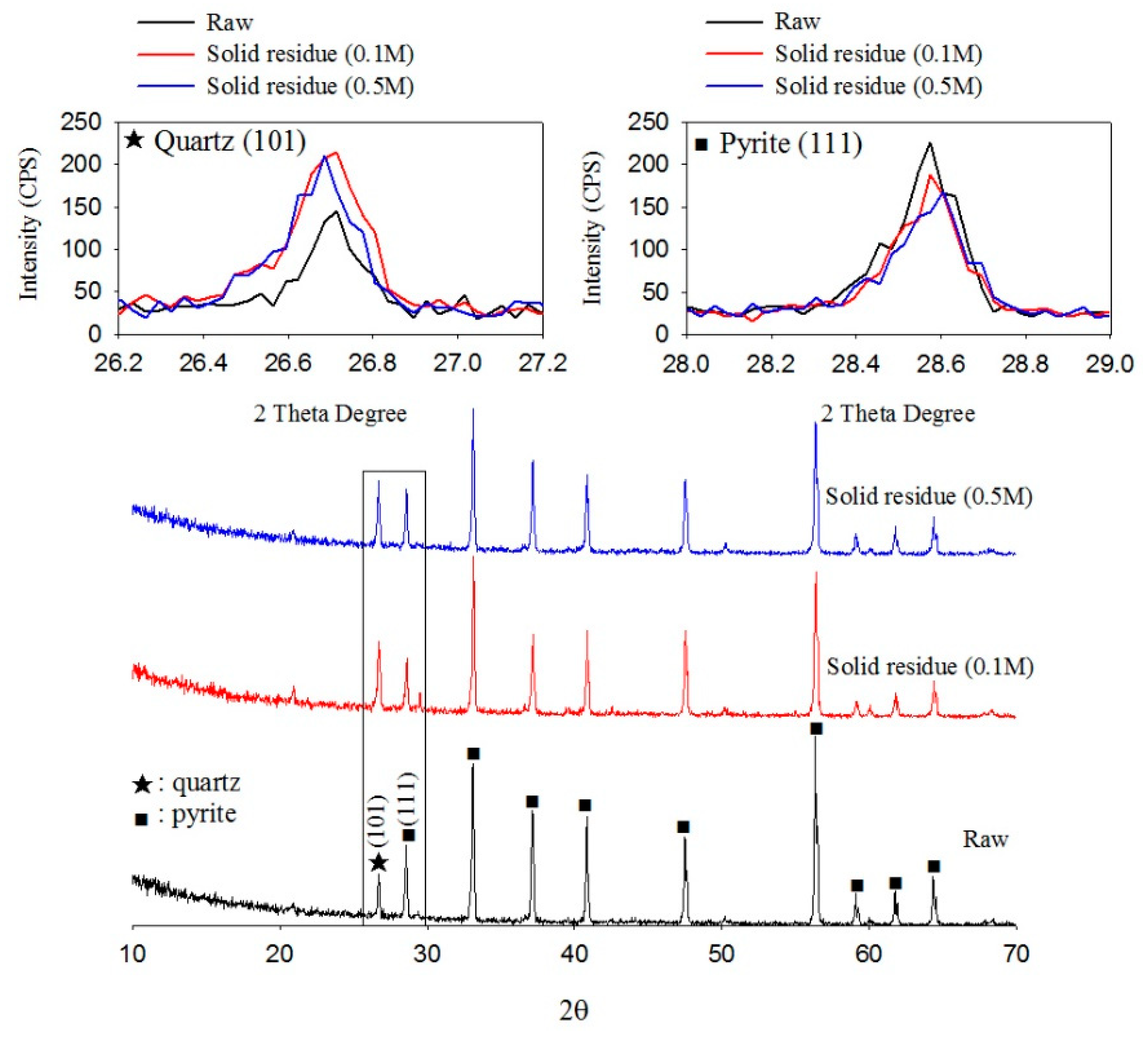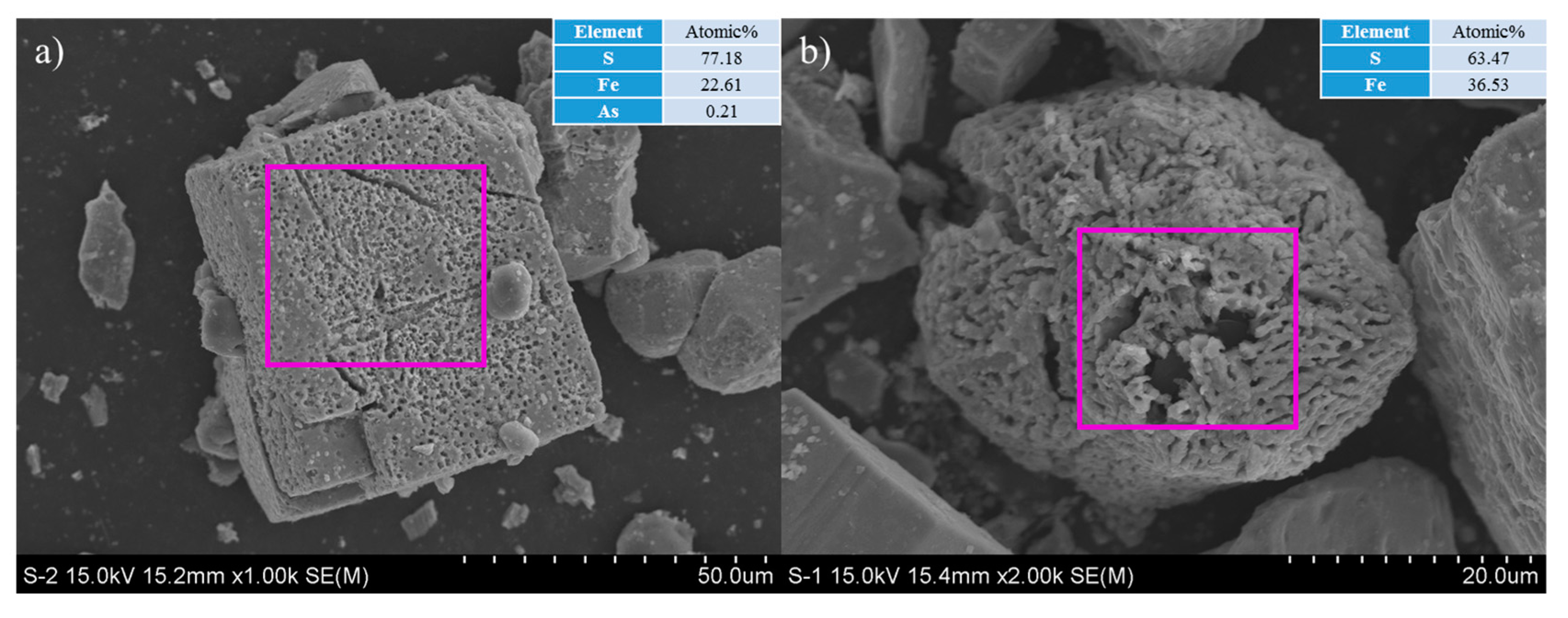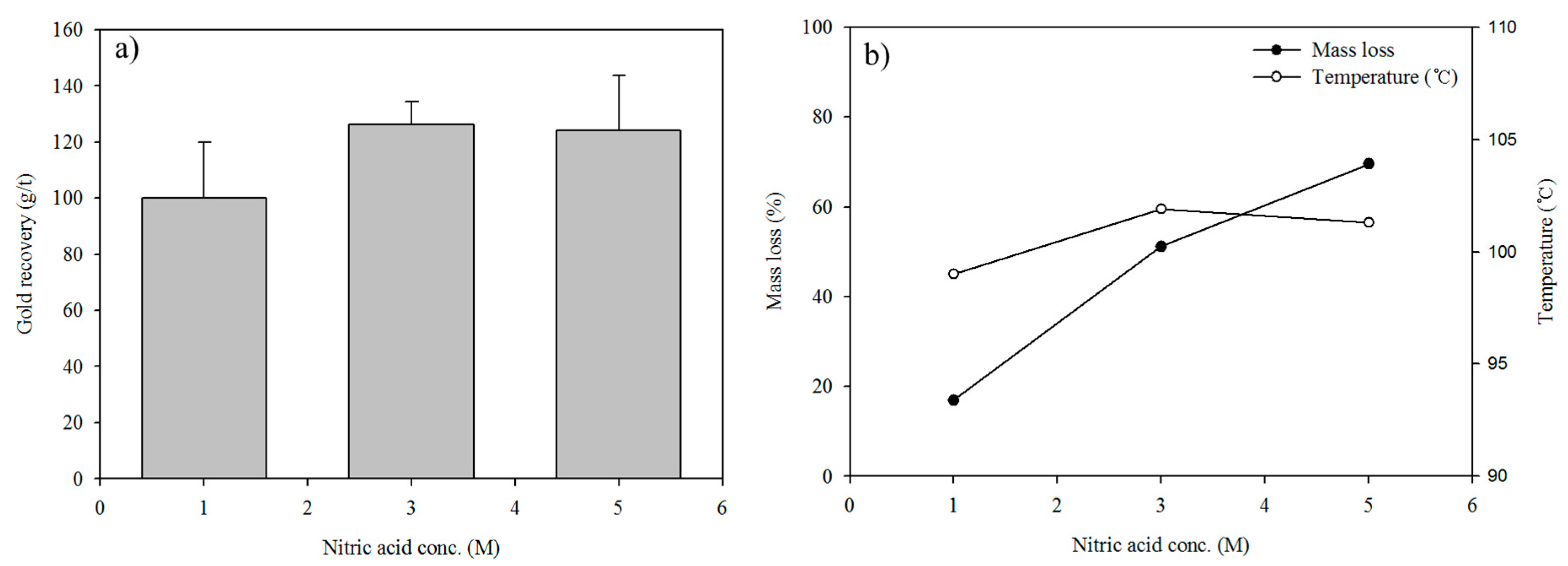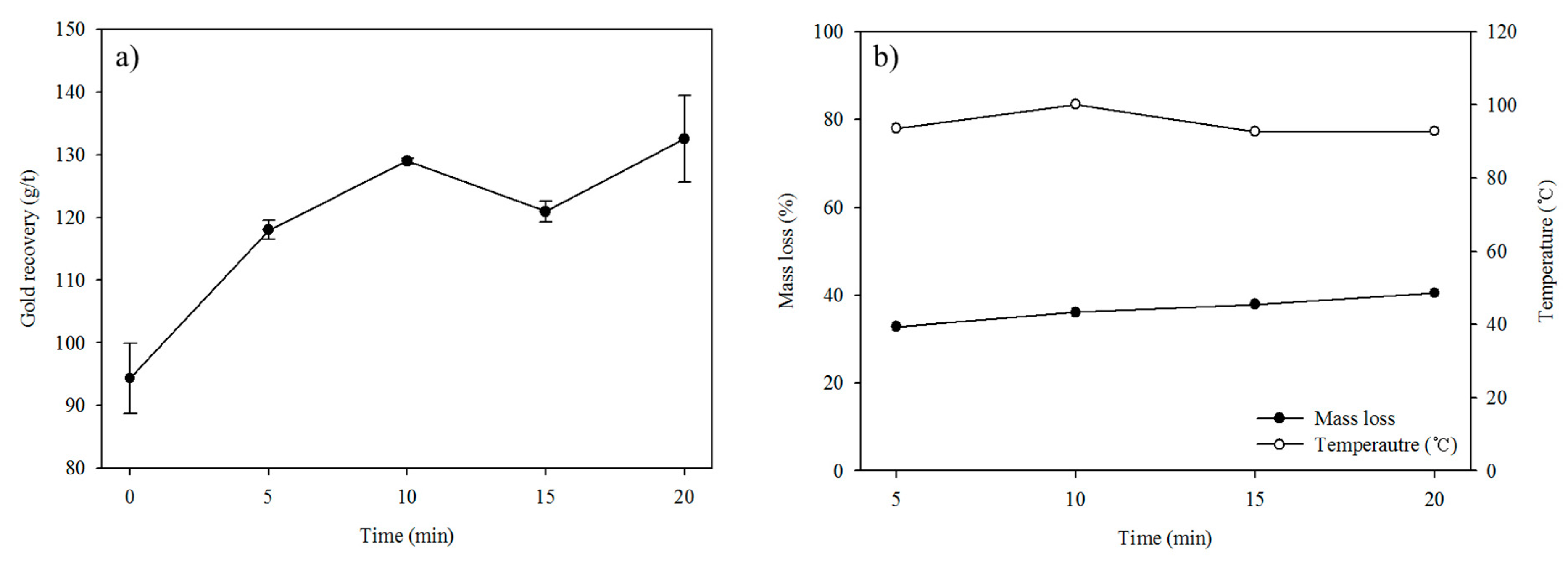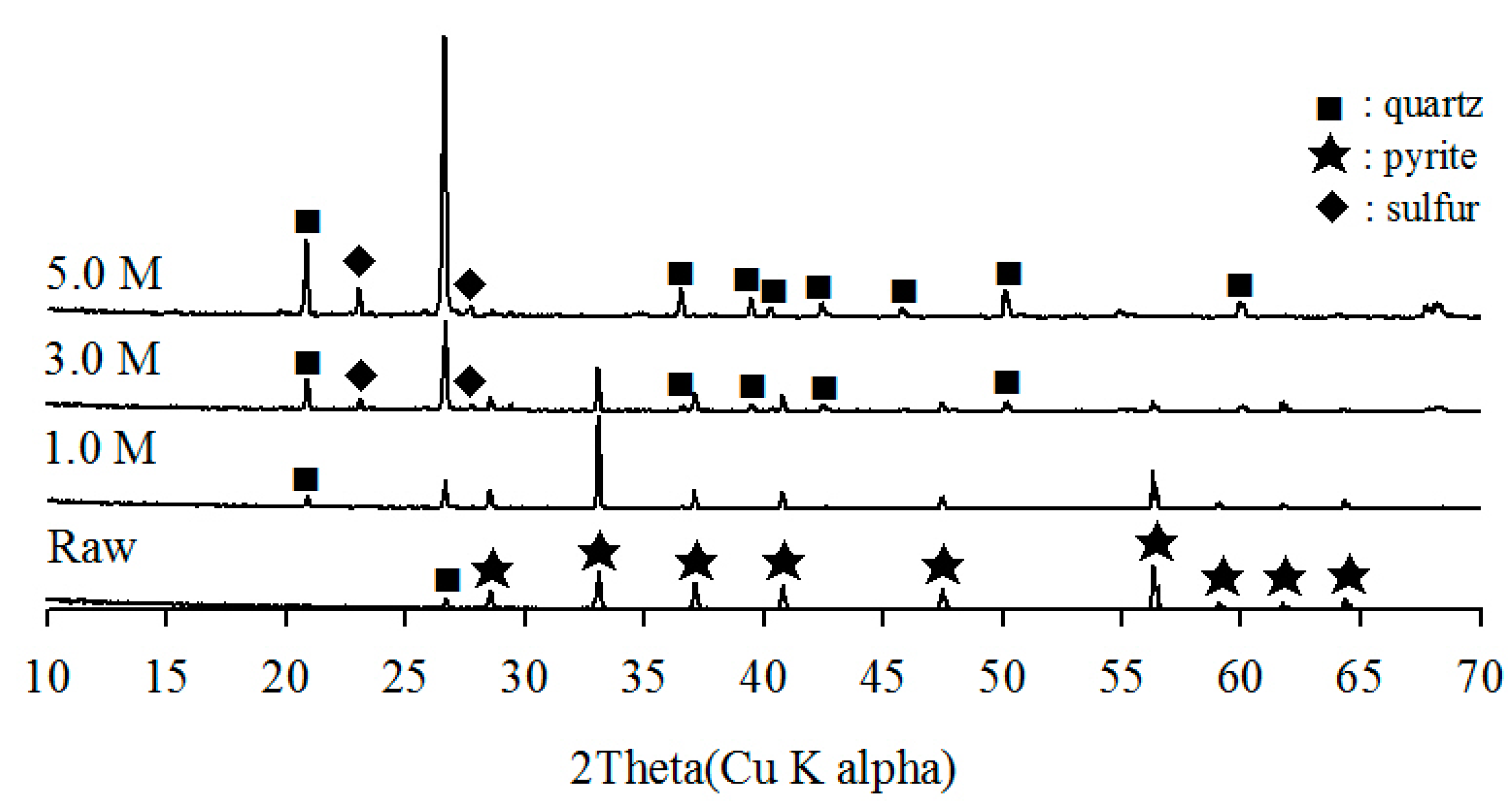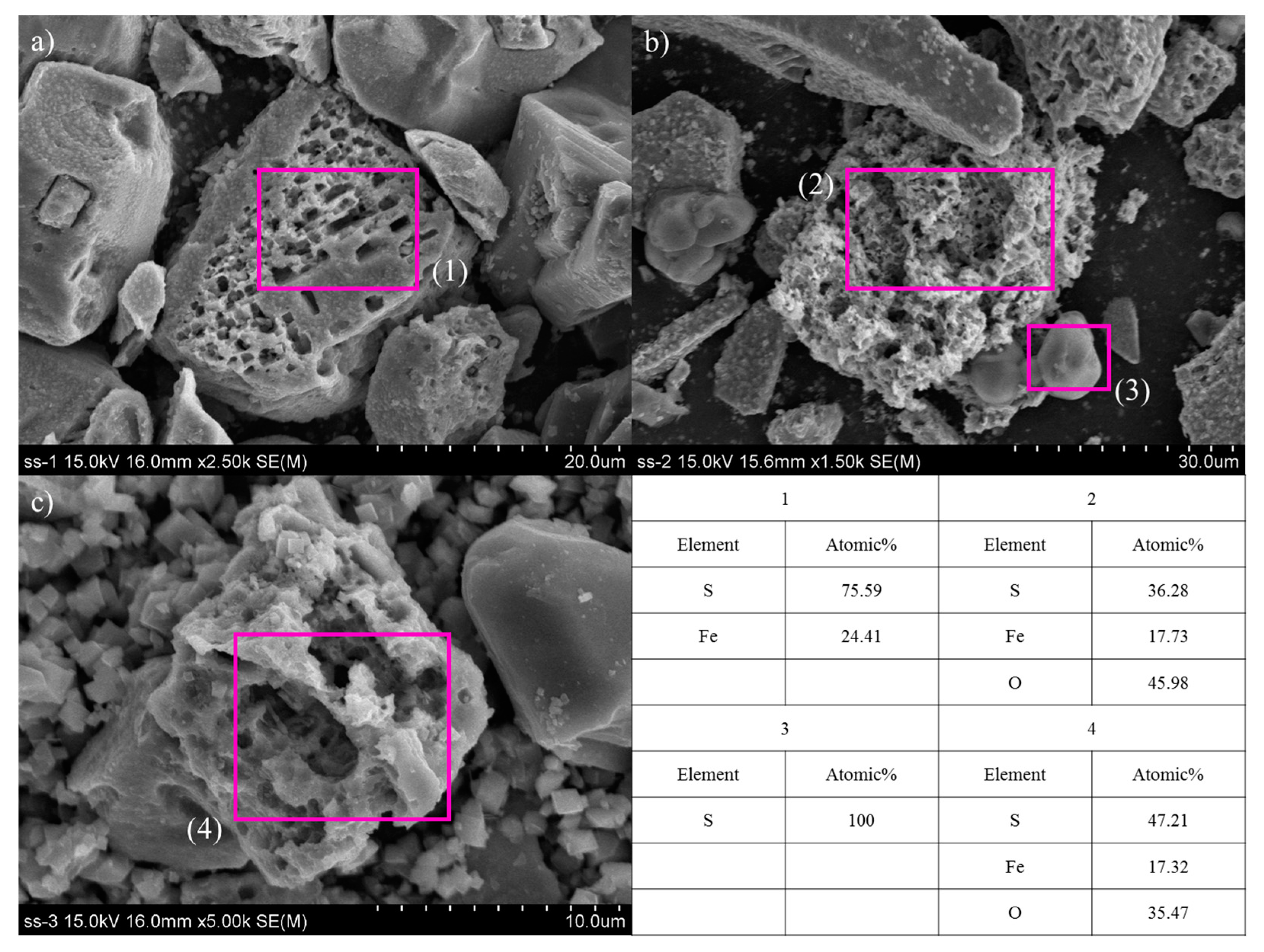1. Introduction
Gold has excellent physical and chemical properties, and is one of the most important noble metals. The current rapid decline in high-grade gold ores and readily available low-grade gold ores has made the mineral processing industry increasingly reliant on complex and refractory gold ores [
1,
2]. Consequently, mineral processing challenges related to the complexities of ore mineralogy and the process parameters, such as the impacts of associated minerals, are important research questions [
3]. Mineralogical studies aim to characterize complex sulfides and show the interrelations of the target minerals in the refractory minerals. In addition, these studies usually analyze gold-bearing sulfide minerals for follow-up processes and efficient gold recovery. Gold can be found in complex sulfide minerals, not only due to the presence of invisible gold, but also due to the existence of solid solutions [
4]. Gold is commonly associated with sulfide minerals, particularly pyrite and arsenopyrite [
5]. A refractory gold ore typically contains different sulfide minerals with various gold concentrations [
6]. Gold is highly encapsulated in the sulfide matrix in refractory gold ores. Pretreatment is an important process to recover gold from sulfide minerals. Gold-bearing ores ordinarily contain complex or refractory ores of sulfide minerals that interfere with gold recovery efficiency. It is necessary to remove sulfide minerals prior to leaching, and the most appropriate pretreatment is flotation and roasting. However, most of the sulfide minerals in a refractory gold concentrate react to form a harmful gas during roasting and the iron oxide produced during roasting encapsulates invisible or fine gold [
7]. Pyrite is the most abundant sulfide mineral in refractory gold ore and its oxidation is thermodynamically favorable in the environment [
8].
The surface oxidation of pyrite is a particularly important step for leaching valuable metals from sulfide minerals. The presence of invisible gold has been established in pyrite, which is a common type of gold-bearing sulfide mineral that is mostly found in association with other sulfide minerals. The gold present in sulfide minerals can be divided into visible gold and invisible gold. While visible gold can be observed with an optical microscope, invisible gold is very difficult to observe with these microscopes. The size of invisible gold may be on the order of nanometers, its presence is indicated by significant refractory imposed by the sulfide minerals (e.g., arsenopyrite, pyrite) [
9]. The hindrance of gold recovery from complex sulfide minerals has been attributed to the formation of a passive layer on the mineral surface. Recent studies [
10,
11,
12,
13,
14] have been conducted on the passive layer effect in sulfide minerals and the role played by sulfur in leaching solutions. In particular, the leaching of galena (PbS) has some problems, due to the low solubility of galena without the presence of an oxidant, the formation of precipitation, and the disposal of a large amount of iron that dissolves along with the lead. Therefore, leaching of the galena has been investigated by many researchers, who have proposed different nitric acid based leaching systems, including HNO
3 [
10], H
2O
2-HNO
3 [
13] and Fe(III)-HNO
3 [
14]. The kinetics of lead dissolution from galena are slow, due to the formation of the passivation layer on the surface of sulfide by oxidation of sulfide, to form elemental sulfur under oxidative conditions. It is known that a partial dissolution or decomposition of sulfide minerals by the leaching solution lowers the leaching rate by forming a passive layer [
11].
Unfortunately, the contributions of reactive sulfur species and the mechanisms of interaction with the leach residue surface are unclear. Therefore, studying the effects of relational minerals on gold is important. The processing of intractable substances presents challenges related to their complexity or refractory minerals. Increasing concerns regarding environmental protection has triggered efforts to identify alternatives that are environmentally friendly. Due to environmental concerns over cyanidation in hydrometallurgy, considerable attention has been dedicated to alternative non-cyanide solutions for refractory gold mineral leaching. Nitric acid has been recognized as one of the most promising reagents to pre-treatment process, and reduce cyanide consumption by refractory gold concentrates. The nitric acid leaching process is advantageous in that it can produce highly oxidizing conditions and is therefore an effective leaching agent for most sulfides [
10]. However, a disadvantage of the nitric acid leaching process is the oxidation of sulfide, both to elemental sulfur and sulfate, in many cases in almost equal parts. This results in an increase in reagent consumption and the necessity of handling sulfate [
10,
13].
The use of microwave-assisted leaching processes has several advantages, including reduced energy consumption and elevated reproducibility [
15,
16]. These characteristics are the main drivers of metal ions in complex sulfide minerals. For example, selective leaching was successfully applied to lead smelting residues. Kim et al. (2017) reported that, when microwave assisted extraction (MAE) and autoclave leaching were performed to solubilize other valuable metals (Cu, Ni, Zn) from the matte, MAE has higher oxidation power than autoclave leaching [
11]. This can explain the higher conversion of Fe sulfides to Fe oxides compared to autoclave leaching, as well as the higher leaching efficiency of Cu, Ni and Zn from their sulfides. Moreover, MAE is a simple process that can save energy and processing costs. Microwave heating has also been applied by Choi et al. [
17] to perform pre-treatment, followed by a thiourea leaching step for gold extraction from gold concentrate. Due to the many advantages of microwaves, they have been widely used in mineral pretreatment. The main purpose of this work is to investigate the leaching behavior of the metals As, Cu, Fe, Zn, and Pb and passive layer decomposition in the refractory gold concentrate associated with nitric acid leaching under various conditions, using a microwave system. Furthermore, to increase the recovery of gold, nitric acid was used during microwave-assisted leaching.
4. Conclusions
The leaching efficiencies of metal ions (As, Cu, Zn, Fe, and Pb) and the recovery of gold from the refractory gold concentrate were investigated using a microwave system. As the acid concentration increased, the metal ion leaching increased, but the leach residues for the low nitric acid concentration (> 0.5 M) consisted mainly of untreated pyrite. The S/Fe ratio determines the surface of the leach residue, which affects the efficiency of passive layer removal. S/Fe ratio in nitric acid leaching with a reaction time of 10 min reached 4.34 at 0.1 M and 4.20 at 0.5 M. It was found that a relatively lower proportion of iron was consumed, and the pyrite in the refractory gold concentrate did not significantly dissolve during nitric acid leaching at > 0.5 M.
In the refractory gold concentrate leaching experiments, nitric acid leaching at high-temperature could limit the decomposition of sulfide minerals, due to the passive layer in the refractory gold concentrate. During the leaching process, As, Cu, Fe, and Zn, leaching increased with time, due to the oxidation of insoluble sulfides to soluble sulfate phases. Initially, the As leaching rate was slow, but steadily increased with increased nitric acid concentration. For the refractory gold concentrate, the As, Cu, Fe, and Zn leaching increased from 7.28% to 84.0% (As), 20.8% to 85.8% (Cu), 9.19% to 98.7% (Fe), and 2.46% to 14.9% (Zn), upon increasing the HNO3 concentration from 0.1M to 1.0M (80 °C, S/L ration 5, leaching time 15 min). As the temperature increased from 80 to 120 °C, the Cu leaching rate constant increased from 0.18 to 0.36 min−1 and the Fe leaching rate constant increased from 0.21 to 0.66 min−1. However, Pb leaching decreased at > 80 °C, due to complex lead and passivation, by increased elemental sulfur formation from the high-temperature oxidation.
Microwave-assisted leaching experiments for gold recovery were conducted for the refractory gold concentrate. More extreme reaction conditions, such as the increase in nitric acid concentration from 1.0 to 5.0 M, facilitated the decomposition of passivation species derived from metal ion dissolution and the liberation of gangue minerals from the sulfide surface. From the comparison between the XRD patterns of the refractory gold concentrate and the leach residues after leaching with different nitric acid concentrations, it can be concluded that pyrite in the sulfide minerals can be destroyed. The SEM-EDS analyses of the leach residue showed that dissolution and decomposition of pyrite in the complex sulfide concentrate leave many vacant areas and microstructures, which can effectively liberate encapsulated gold and improve the recovery of gold.
The recovery rate of gold in the leach residue was improved with microwave-assisted leaching and the gold recovery was about 132.55 g/t after 20 min of the leaching experiment (nitric acid at 2.0 M), according to fire assays. The effect of the increase in nitric acid concentration was consistent with increased exposure to reactive sulfide minerals, which could effectively liberate, encapsulate and improve the gold recovery rate.
The current rapid decline in high-grade gold ores has made the mineral processing industry increasingly reliant on complex and refractory gold ores. At present, several approaches have been employed for mineral processing, including metallurgy and hydro-metallurgy. The leaching process is a method used in hydrometallurgy, which is used to leach base and precious metals from source materials. Particularly, percolation leaching methods, such as Heap leaching, dump leaching, bioleaching and in situ leaching, have been very effective in extracting metals from low grade ores, which could not otherwise be economically extracted. However, the challenge of this facility has been the handling of waste and control of environmental pollution caused by toxic leakages from heaps [
26]. In addition, the formation of complex or refractory substances has limited its application. The main reason for this is that the complex or refractory ores require more processing and the various approaches used for gold recovery are challenging to perform in aqueous solutions, owing to surface passivation.
Gold-bearing ores contain pyrite, chalcopyrite, arsenopyrite, and galena, which interfere with gold recovery and lower its efficiency. Therefore, studying the effects of relational minerals on gold is important. Among the alternative processes, the use of microwave additives followed by leaching is important for the recovery of precious metals from complex or refractory minerals. To increase the recovery of gold, the microwave-assisted leaching process may be used as a process to address the formation of complex or refractory sulfide minerals.
Author Contributions
H.K.: Experiment, Investigation; E.M.: Formal analysis, Visualization; O.P.: Formal analysis; N.C.: Funding acquisition, Conceptualization; C.P.: Project administration, Conceptualization; K.C.: Writing-original draft, Writing-review & editing. All authors have read and agreed to the published version of the manuscript.
Funding
This study was supported by the Korea Ministry of Environment (MOE), South Korea, as an Advanced Industrial Technology Development Project (No. 2016000140010).
Conflicts of Interest
The authors declare no conflicts of interest.
References
- Adams, M.D. Gold Ore Processing: Project Development and Operations, 2nd ed.; Elsevier: Cambridge, MA, USA, 2016; pp. 57–94. [Google Scholar]
- Senanayake, G. A review of effects of silver, lead, sulfide and carbonaceous matter on gold cyanidation and mechanistic interpretation. Hydrometallurgy 2008, 90, 46–73. [Google Scholar] [CrossRef]
- Feng, D.; Van Deventer, J. Effect of thiosulphate salts on ammoniacal thiosulphate leaching of gold. Hydrometallurgy 2010, 105, 120–126. [Google Scholar] [CrossRef]
- Hough, R.; Noble, R.; Reich, M. Natural gold nanoparticles. Ore Geol. Rev. 2011, 42, 55–61. [Google Scholar] [CrossRef]
- Asamoah, R.K.; Skinner, W.; Addai-Mensah, J. Alkaline cyanide leaching of refractory gold flotation concentrates and bio-oxidised products: The effect of process variables. Hydrometallurgy 2018, 179, 79–93. [Google Scholar] [CrossRef]
- Cho, K.H.; Lee, J.J.; Park, C.Y. Liberation of Gold Using Microwave-Nitric Acid Leaching and Separation-Recovery of Native Gold by Hydro-Separation. Minerals 2020, 10, 327. [Google Scholar] [CrossRef]
- Kusebauch, C.; Oelze, M.; Gleeson, S.A. Partitioning of arsenic between hydrothermal fluid and pyrite during experimental siderite replacement. Chem. Geol. 2018, 500, 136–147. [Google Scholar] [CrossRef]
- Li, J.; Dabrowski, B.; Miller, J.; Acar, S.; Dietrich, M.; LeVier, K.; Wan, R. The influence of pyrite pre-oxidation on gold recovery by cyanidation. Miner. Eng. 2006, 19, 883–895. [Google Scholar] [CrossRef]
- Zia, Y.; Mohammadnejad, S.; Abdollahy, M. Gold passivation by sulfur species: A molecular picture. Miner. Eng. 2019, 134, 215–221. [Google Scholar] [CrossRef]
- Zárate-Gutiérrez, R.; Lapidus, G.; Morales, R. Aqueous oxidation of galena and pyrite with nitric acid at moderate temperatures. Hydrometallurgy 2012, 115, 57–63. [Google Scholar] [CrossRef]
- Kim, E.; Horckmans, L.; Spooren, J.; Vrancken, K.; Quaghebeur, M.; Broos, K. Selective leaching of Pb, Cu, Ni and Zn from secondary lead smelting residues. Hydrometallurgy 2017, 169, 372–381. [Google Scholar] [CrossRef]
- Han, B.; Altansukh, B.; Haga, K.; Takasaki, Y.; Shibayama, A. Leaching and Kinetic Study on Pressure Oxidation of Chalcopyrite in H2SO4 Solution and the Effect of Pyrite on Chalcopyrite Leaching. J. Sustain. Metall. 2017, 3, 528–542. [Google Scholar] [CrossRef]
- Aydoğan, S.; Erdemoğlu, M.; Uçar, G.; Aras, A. Kinetics of galena dissolution in nitric acid solutions with hydrogen peroxide. Hydrometallurgy 2007, 88, 52–57. [Google Scholar] [CrossRef]
- Kholmogorov, A.G.; Pashkov, G.L.; Mikhlina, E.V.; Shashina, L.V.; Zhizhaev, A.M. Activation of hydrometallurgical treatment of PbS in nitric solutions. Chem. Sustain. Dev. 2003, 11, 879–881. [Google Scholar]
- Al-Harahsheh, M.; Kingman, S. Microwave-assisted leaching—A review. Hydrometallurgy 2004, 73, 189–203. [Google Scholar] [CrossRef]
- Zhang, X.; Liu, F.; Xue, X.; Jiang, T. Effects of microwave and conventional blank roasting on oxidation behavior, microstructure and surface morphology of vanadium slag with high chromium content. J. Ailloy. Compd. 2016, 686, 356–365. [Google Scholar] [CrossRef]
- Choi, N.-C.; Kim, B.-J.; Cho, K.; Lee, S.; Park, C.-Y. Microwave pretreatment for thiourea leaching for gold concentrate. Metals 2017, 7, 404. [Google Scholar] [CrossRef]
- Cromie, P.; Makoundi, C.; Zaw, K.; Cooke, D.R.; White, N.; Ryan, C. Geochemistry of Au-bearing pyrite from the Sepon Mineral District, Laos DPR, Southeast Asia: Implications for ore genesis. J. Asian Earth Sci. 2018, 164, 194–218. [Google Scholar] [CrossRef]
- Santos-Munguía, P.; Nava-Alonso, F.; Rodríguez-Chávez, V.; Alonso-González, O. Hidden gold in fire assay of gold telluride ores. Miner. Eng. 2019, 141, 105844. [Google Scholar] [CrossRef]
- Choi, N.-C.; Kim, B.-J.; Cho, K.-H.; You, D.-S.; Park, C.-Y. Enhancement of gold recovery during lead fire assay by salt-roasting. Geosystem Eng. 2014, 17, 226–234. [Google Scholar] [CrossRef]
- Kim, E.; Roosen, J.; Horckmans, L.; Spooren, J.; Broos, K.; Binnemans, K.; Vrancken, K.C.; Quaghebeur, M. Process development for hydrometallurgical recovery of valuable metals from sulfide-rich residue generated in a secondary lead smelter. Hydrometallurgy 2017, 169, 589–598. [Google Scholar] [CrossRef]
- Gan, M.; Gu, C.; Ding, J.; Zhu, J.; Liu, X.; Qiu, G. Hexavalent chromium remediation based on the synergistic effect between chemoautotrophic bacteria and sulfide minerals. Ecotoxicol. Environ. Saf. 2019, 173, 118–130. [Google Scholar] [CrossRef]
- Zhao, L.; Chen, Y.; Liu, Y.; Luo, C.; Wu, D. Enhanced degradation of chloramphenicol at alkaline conditions by S (-II) assisted heterogeneous Fenton-like reactions using pyrite. Chemosphere 2017, 188, 557–566. [Google Scholar] [CrossRef] [PubMed]
- Feng, J.; Tian, H.; Huang, Y.; Ding, Z.; Yin, Z. Directional Oxidation of Pyrite in Acid Solution. Minerals 2019, 9, 7. [Google Scholar] [CrossRef]
- Rogozhnikov, D.A.; Shoppert, A.A.; Dizer, O.A.; Karimov, K.A.; Rusalev, R.E. Leaching Kinetics of Sulfides from Refractory Gold Concentrates by Nitric Acid. Metals 2019, 9, 465. [Google Scholar] [CrossRef]
- Ilankoon, I.M.S.K.; Tang, Y.; Ghorbani, Y.; Northey, S.; Yellishetty, M.; Deng, X.; McBride, D. The current state and future directions of percolation leaching in the Chinese mining industry: Challenges and opportunities. Miner. Eng. 2018, 125, 206–222. [Google Scholar] [CrossRef]
Figure 1.
Schematic diagram of microwave-assisted leaching system.
Figure 2.
Microphotographs of gold ore samples. Reflected light microscopy of the etching of pyrite grains (a) before and (b) after etching in HNO3 solution. Ccp is chalcopyrite and Py is pyrite.
Figure 3.
SEM-EDS (Scanning Electron Microscopy-Energy-dispersive X-ray spectroscopy) of pyrite in the refractory gold concentrate.
Figure 4.
Effect of HNO
3 concentration on the leaching efficiencies of As, Cu, Zn, and Fe from the refractory gold concentrate. The leaching conditions were a reaction time of 15 min, reaction temperature of 80 °C, and HNO
3 concentration of 0.1, 0.5, or 1.0 M. According to Equation (2) in
Table 2.
Figure 5.
Effect of temperature on the leaching efficiencies of As, Cu, Zn, and Fe from the refractory gold concentrate. The leaching conditions were a reaction temperature between 80 and 120 °C, HNO
3 concentration of 1.0 M, and reaction time of 15 min. According to Equation (2) in
Table S2.
Figure 6.
Effect of temperature on the leaching efficiencies of Pb (a) and ORP (mV) (b) from the refractory gold concentrate. The leaching conditions were an HNO3 concentration of 1.0 M, reaction time of 15 min, and reaction temperatures of 40, 80, and 120 °C.
Figure 7.
XRD patterns of raw and leach residue from nitric acid leaching at 40, 80, and 120 °C. The leaching conditions were an HNO3 concentration of 1.0 M and a reaction time of 15 min.
Figure 8.
Effect of temperature on the leaching efficiencies of Pb and Fe from the refractory gold concentrate. The leaching conditions were an HNO3 concentration of 1.0 M and a reaction temperature of 40, 80 and 120 °C.
Figure 9.
XPS spectra of Fe2p for (a) raw concentrate, (b) leach residue (0.1 M), (c) leach residue (0.5 M), and (d) distribution of the surface Fe species. The leaching conditions were 80 °C and 15 min.
Figure 10.
XPS spectra of S2p for (a) raw concentrate, (b) leach residue (0.1 M), (c) leach residue (0.5 M), and (d) distribution of the surface S species. The leaching conditions were 80 °C and 15 min.
Figure 11.
XRD patterns of raw and leach residue from nitric acid leaching at 0.1 and 0.5 M. The leaching conditions were 80 °C and 15 min.
Figure 12.
SEM images of leach residues. The leaching conditions were 80 °C, 15 min, and HNO3 concentration of (a) 0.1 M and (b) 0.5 M.
Figure 13.
Effect of HNO3 concentration on the (a) recovery of gold and (b) mass loss and reaction temperature from the refractory gold concentrate. The leaching conditions were a reaction time of 15 min and an HNO3 concentration of 1.0, 3.0 and 5.0 M.
Figure 14.
Effect of leaching time on (a) recovery of gold and (b) mass loss and reaction temperature from the refractory gold concentrate. The leaching conditions were an HNO3 concentration of 2.0 M.
Figure 15.
XRD patterns of raw and leach residue from nitric acid leaching at 1.0, 3.0 and 5.0 M. The leaching time was 15 min.
Figure 16.
SEM images of the leach residues from nitric acid leaching at (a) 1.0 M, (b) 3.0 M and (c) 5.0 M. The leaching time was 15 min.
Table 1.
Chemical composition of the complex sulfide concentrate.
| Cu (wt%) | Pb (wt%) | Zn (wt%) | Fe (wt%) | As (g/t) | Au (g/t) |
|---|
| 0.19 | 0.15 | 0.63 | 43.86 | 0.10 | 94.37 |
Table 2.
Refractory gold concentrate and leach residue surface atomic composition with different treatments. The leaching conditions were a reaction temperature of 80 °C reaction time of 15 min, and HNO3 concentration of 0.1 and 0.5 M.
| Experiment | S2p (%) | Fe2p (%) | S/Fe ratio (%) | As3d (%) |
|---|
| Raw | 44.52 | 39.64 | 1.12 | 6.39 |
| Residue 0.1 M | 77.79 | 17.93 | 4.34 | 0.11 |
| Residue 0.5 M | 78.50 | 18.69 | 4.20 | - |
© 2020 by the authors. Licensee MDPI, Basel, Switzerland. This article is an open access article distributed under the terms and conditions of the Creative Commons Attribution (CC BY) license (http://creativecommons.org/licenses/by/4.0/).

